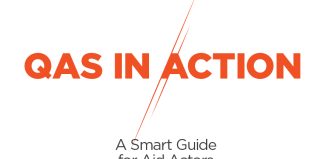Spotlight on people management tools: Core Humanitarian Competency Framework
Competent and well-managed staff are at the heart of an accountable and effective organisation, therefore they need to be equipped with the right skills and behaviours. The Core Humanitarian Competency Framework explains the link between the organisation’s ability to deliver impact, and what it takes to be successful through personal and organisational excellence.
Some background
The Core Humanitarian Competencies Framework (CHCF) as first developed in 2011, by representatives from a cross-section of humanitarian organisations under the Consortium of British Humanitarian Agencies (now the Start Network) led by ActionAid and facilitated by People In Aid (now the CHS Alliance). The competencies framework recommends a set of core competencies that organisations could adopt to systematically build the skills of their employees and thereby improve their efforts to assist people affected by crisis throughout the world. Six areas of core competencies defined as “the essential behaviours required by all staff, influenced by their skills and knowledge”, were identified. The framework was successfully embedded in many of the participating agencies’ operations and members of CHS Alliance.
Ten years on, is the CHCF fit for purpose?
In 2017, and as part of the Start Network/DFID-funded Talent Development Project (TDP), the CHS Alliance completed a review of the CHCF taking feedback from a wide range of stakeholders on the relevance and practical use of the CHCF in humanitarian organisations, and asking for recommendations for its revision.
The review affirmed that the CHCF is fit for purpose, adds value and is highly relevant for staff development and humanitarian efforts in general and serves as a useful reference point. The review, however, also indicated that there was only low to moderate level awareness and hence corresponding lack of ‘know how’ of the CHCF. It was unclear how it links to career paths, how changes in behaviours can be identified and measured, and HR practitioners were not familiar enough with competency frameworks to guide project managers and field staff on how to adopt them.
There were encouraging cases of how the framework has been used in various contexts, suggesting that it is an important tool to professionalise the sector. The review also revealed that it would be helpful to have more tools on how to use the framework.
Following the review, additional materials and tools were developed, translated to several languages and made accessible to support the application of competency-based human resources (HR) management practices, including an introductory animation in six languages!
To download the CHCF guide, click here.
How is CHCF used within CHS Alliance’s membership?
Three years after the review, we have decided to put the CHCF under the spotlight and share the “user experience” feedback from two very different Alliance members who have adopted the framework.*
To help more of our members understand how to get the most out of the CHCF, as well as practical considerations for rolling it out, we hear from:

Asma Shehzad, Head of Support, Community World Service Asia

Colin Rogers, Head of Disaster Preparedness & Response, Plan International
When and how did your organisation first implement the CHCF?
Asma Shehzad (AS): We started this process back in 2017 by working on the CHCF with CHS Alliance for piloting within Pakistan through academia. The initial idea was to share the framework with our partner universities in Pakistan and develop a tool/guide for teachers to assess student performances on competencies. Later, in 2018 we started the implementation process of CHCF within our own organisation. In 2020 we moved to include the framework in our Annual Appraisal System, which means all CWSA employees will now be evaluated against the core competencies highlighted in their job descriptions. All staff have now been briefed on the new appraisal system, the core competencies and how to appraise against them.
Colin Rogers (CR): It is only more recently that we have started to integrate the CHCF into our work. We chose to focus on the competencies required for Plan International staff to join our roster for surge capacity.
Why did you decide to adopt the CHCF in your organisation?
CR: For us, it was important as we sought to build the strength of our roster, ensuring we had the right people with the right competencies who we could deploy within Plan International to provide additional surge capacity when our Country Offices were responding to new crises.
Using the CHCF provides Country Offices with reassurance that the deploying staff member has the right competencies to support their response activities. It also provides a framework for evaluating applicants who want to join our roster.
We are now looking at how to use the CHCF to develop standard competencies against emergency response job profiles, integrating the CHCF into the role profile, and also framing interview selection questions around the CHCF. This is based on a request from our country office teams who are looking for a level of guidance on hiring humanitarian staff.
AS: We felt that the CHCF could providing clarity to all staff about the behaviour and competencies the organisation expects from them, from recruiting through to retainment. CHCF helps to focus employees’ behaviour on things that matter most in a humanitarian or development organisation. The CHCF provides a common and standardised way to harmonise, select and develop talent.
What areas of your organisation did you start with?
AS: We embedded the CHCF in job descriptions, annual performance appraisals, the recruitment process and also objective setting at the beginning of each calendar year.
CR: Our emergency response roster was our starting point and this is now being expanded to other areas of humanitarian staffing.
How has the implementation of the CHCF in your organisation evolved?
CR: This is still very much a piece of work in progress. We have been revising our Emergency Response Manual and as part of this we are looking at how to integrate the CHCF in to our guidance to support country offices identify competencies needed for programme technical specialists.
AS: We have moved step by step since adopting the framework in 2018 and have come a long way since then. The framework is part and parcel of all our organisational activities whether at head office or in the field.
We started with development of job descriptions, aligning them with CHCF, then we moved to the appraisal system, and are now crafting all our recruitment procedures according to the framework. We have trained our staff through various capacity enhancement platforms and have now finally embedded it into most of our HR systems.
What were the main challenges? What about successes?
AS: Introducing a new framework and resultant policies and practices requires significant investment of resources, technical expertise, staff time and energy alongside other competing priorities.
Initially it was a challenge to develop understanding on CHCF framework. For that we had to conduct a number of sessions with staff so that they could have clear understanding of it.
Most of the references in the framework are linked to people in humanitarian crises, which might not be the case for many situations in our work. We took on the challenge by contextualising examples to our own working scenarios.
It was also a challenge to link this framework with support staff like drivers, helpers etc. As key stakeholders in our operations, it was vital they complied with the institutional stance including the CHCF.
For countries where English is not the first language, explaining the CHCF and helping staff apply it in their appraisals and job descriptions has been a challenge. The framework needs to be explained simply to be understood and applied. It has proven more complicated to roll out for staff in our project implementing countries.
However, the hard work is paying off as we have seen a number of successes. It’s really helped us to focus on key competencies for each position – making our objectives more purposeful. Annual appraisals have also become more relevant and result oriented.
By clarifying the competencies we expect our staff to achieve, and by explaining how they link to the organisation’s ability to deliver impact, we have been able to send clear messages about what is expected to be successful and attain personal and organisational goals effectively.
CR: I’d say that the main challenge has been a lack of familiarity with the CHCF outside of the Disaster Risk Management team.
What are your future plans for the CHCF? Do you think any further guidance and support is needed?
AS: We are planning to implement the CHCF in all our HR processes, next up is integrating the framework into our interview and supervisors’ assessments.
We would appreciate sessions to develop further understanding of the framework. We are also hoping to see a more localised collective approach to applying CHCF by Alliance members.
CR: We plan to use the CHCF to guide recruitment, designing job descriptions and developing interview questions. This is of interest for our Country Offices who have asked for guidance on how to recruit the right level of staff with the relevant competencies required to support their humanitarian response activities. We want to ensure a diversity of people on our roster and who are hired. We are also looking at how to use the CHCF to help us update our core learning and development programmes for roster members.
How does the application of a competency framework improve the overall effectiveness and accountability of your organisation?
CR: Whilst the competency framework is not embedded across the whole organisation, we hope that it will support establishing key requirements for different technical and managerial positions. Recruiting with the framework in mind will ensure that Plan recruits at the appropriate capacity level to fulfil our dual mandate as a development and humanitarian organisation.
AS: Competencies have helped Community World Service Asia to identify the visible behaviours that successful performers should demonstrate while working on any given job.
Focusing on competencies has underpinned the progression and success of the organisation.
How and where should organisations start if they are interested in adopting competency-based approach?
AS: The following steps are key to start with:
- Support and buy-in from leadership.
- Staff must fully commit and understand the framework.
- Making the framework part of organisational standards.
- Adopting it to local contexts.
- Ensure feedback is taken and given.
- Link the CHCF to existing HR processes, forms and formats.
CR: Identify windows of opportunity, small areas of work where you can demonstrate the impact and the usefulness. From this you generate buy in and support and this in turn leads to greater integration. Don’t give up – persevere and you will find your job descriptions become clearer, and the interview and selection process easier and with that stronger programmes with greater impact.
We are currently evaluating people management resources of the CHS Alliance with the intention to ensuring their content, format and purpose continue to meet organisational and user needs of our members.
If you are using the CHCF in your organisation, we would greatly appreciate hearing your views and learning from your experience. Please contact Gozel Baltaeva on gbaltaeva@chsalliance.org for more.
* Some responses have been edited for clarity and brevity.







